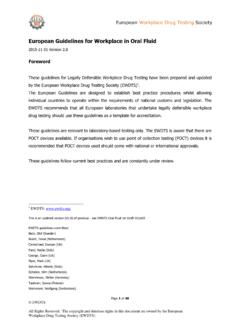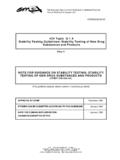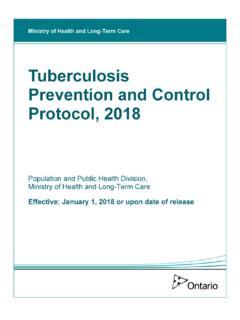Transcription of European Laboratory Guidelines for Legally Defensible ...
1 European Laboratory Guidelines for Legally Defensible Workplace drug testing 1. Urine drug testing European Laboratory Guidelines for Legally Defensible Workplace drug testing Version These Guidelines for Legally Defensible Workplace drug testing have been prepared by the European Workplace drug testing Society (EWDTS). They are based on the UK Guidelines drawn up by a Steering Group representing the following UK analytical laboratories: Cardiff BioAnalytical Services Medscreen Department of Forensic Medicine & Newcastle Royal Infirmary Science, University of Glasgow Toxicology Department, Forensic Science Service OmniLabs JMJ Laboratories Scientifics LGC Tackler Analytical London Toxicology Group The European Guidelines are designed to establish best practice procedures whilst allowing individual countries to operate within the requirements of national customs and legislation. The detail within the appendices will therefore vary from country to country.
2 The EWDTS is the owner of these Guidelines . They relate only to the collection of urine samples, their Laboratory analysis, and subsequent interpretation of the results, and must be used in their entirety. Subsequent versions will be issued at the discretion of the EWDTS. EWDTS Guidelines Committee Mostert, The Netherlands, Chair S. Suominen, Finland, Secretary O. Beck, Sweden L. Hadfield, representative of UK Steering Group C. Fernandez, Spain G. Kauert, Germany EWDTS 2002. Page 2 of 39. European Laboratory Guidelines for Legally Defensible Workplace drug testing Version Table of Contents 1 General 5. Introduction 5. Objectives 5. Scope 5. Definitions 6. Service Provision 6. drug testing in Context 6. Outline of drug testing process 7. Laboratory Security 8. 2 Specimen collection 9. Overview 9. Personnel 9. Procedures 9. Specimen Collection Kits 10. Chain of Custody Form 10. 3 Laboratory Organisation 11. Personnel 11.
3 Laboratory Head 11. Authorising Scientist 12. Laboratory Analyst 13. Toxicologist 13. Expert Witness 14. Other Personnel 14. Quality Manager 14. 4 Laboratory Analysis Procedures 15. Summary 15. Chain of Custody 15. Receiving/Accessioning 15. Sample Processing 16. EWDTS 2002. Page 3 of 39. European Laboratory Guidelines for Legally Defensible Workplace drug testing Version Urine validity testing 16. Screen Test 17. Standardisation of screen assays 18. Confirmation Test 18. Authorisation and reporting of Results 19. Long-Term Storage of Samples 19. Records 20. 5 Quality Assurance and Quality Control 21. Quality assurance 21. Quality Control 21. Screen Tests 22. Confirmation tests 22. Quality assessment 23. Sub-contracting 24. 6 Challenges to drug Test Results 25. 7 Interpretation of Results 26. Toxicology Review 26. 8 Definitions 27. Appendix A Urine Collection Procedures - an example of a typical protocol appropriate for [country] 30.
4 Appendix B Example of a Donor's Statement of Informed Consent appropriate for [country] 34. Appendix C Some examples of flaws in the Chain of Custody 35. Appendix D Acceptable Screening Techniques 36. Appendix E Recommended maximum cut-off concentrations for Screening Tests appropriate for [country] 37. Appendix F Recommended cut-off concentrations for confirmation tests appropriate for [country] 38. Appendix G Medical Review 39. EWDTS 2002. Page 4 of 39. European Laboratory Guidelines for Legally Defensible Workplace drug testing Version General Introduction These Guidelines represent an overview of the best practice for laboratories providing workplace drug testing services within Europe. They are based on the general principles that have been established internationally. They are designed to ensure that the entire drug testing process is conducted to give accurate and reliable information about a donor's drug use.
5 All laboratories that undertake Legally Defensible workplace drug testing within Europe should use these Guidelines as a template for accreditation. These Guidelines focus on urine, which is the usual specimen for analysis. However the same general principles should be applied for all specimen types. Objectives The Guidelines are designed to Provide a minimum set of criteria for the providers of workplace drug testing services within Europe. Ensure that the processes undertaken are capable of legal scrutiny. Provide safeguards to protect the specimen donors. Define for laboratories common quality assurance and quality control criteria that are capable of being accredited by an external body. Scope These Guidelines consider the three key stages of the workplace drug testing process. Obtaining the specimen from the donor (specimen collection). Analysis of the sample for the presence of drugs ( Laboratory analysis).
6 Review and interpretation of the analytical results (interpretation). EWDTS 2002. Page 5 of 39. European Laboratory Guidelines for Legally Defensible Workplace drug testing Version Definitions Within this document the following definitions apply: Service Provider: The organisation contracted to provide the drug testing service. This may be a Laboratory , or a third party providing other elements of the service, and contracting with a Laboratory . Laboratory : The facility providing the analytical services to detect drugs of abuse. Customer: The organisation requesting the drug testing service. Donor: The person providing the specimen for analysis. Further definitions relating to elements of the services are provided in Section 8. Service Provision Where a service provider is contracted to deliver all the stages, they must ensure that the minimum criteria in this document are met in all the key areas. In those instances where a customer may undertake some stages of the process within their own organisation ( specimen collection or interpretation), the service provider has a 'duty of care' to ensure that the customer understands the full implications of the drug testing process.
7 The service provider does not have the authority to make decisions regarding the fitness for work of any individual being tested. It is recommended that any issues related to fitness for work be referred to the company's medical representative. drug testing in Context It should be explained to any purchaser of a Laboratory drug testing service that drug testing should form part of an overall drug policy, which the purchaser has agreed with his employees and should have in place before testing is initiated. EWDTS 2002. Page 6 of 39. European Laboratory Guidelines for Legally Defensible Workplace drug testing Version The service provider should have an effective company drugs policy in place. The policy may include drug testing of the staff involved in the analysis and reporting of workplace drug testing results. Outline of drug testing process Collection The usual specimen collected for analysis is urine. Urine specimens for Legally Defensible drug testing need to be collected under circumstances which respect the dignity of the individual whilst ensuring that the sample is freshly voided.
8 Suitable records must be made when the specimen is collected to prove that the specimen collected and the sample received by the Laboratory is one and the same. This is the first link in the chain of custody process which, when reconstructed at a later date, can be used to prove that the final result belongs to the specimen collected. Analysis When the sample is received at the Laboratory , checks on the integrity of the sample are carried out. Providing the sample passes the integrity checks a portion of the sample is taken and screened for the presence of drugs. If the screen results are all negative no further analysis is necessary. However if the screen tests carried out indicate the possible presence of a drug (above a predefined cut-off level) a confirmation test to prove or disprove the presence of the drug indicated by the screening test must be carried out on another portion of the sample. When a negative result is obtained, either after the screen or confirmation test, it can be reported to the customer.
9 Positive results may require interpretation. Interpretation EWDTS 2002. Page 7 of 39. European Laboratory Guidelines for Legally Defensible Workplace drug testing Version A Laboratory positive result may be due to other reasons than intake of illicit drugs ( medication (prescribed or over-the- counter) or to dietary causes). It requires interpretation that is best carried out by the Laboratory toxicologist in conjunction with a qualified medical practitioner who can consult both with the donor and the donor's medical practitioner. Record Keeping Suitable records must be made during the analytical process to prove that the sample received by the Laboratory and the sample, about which the final report is written, are one and the same. All samples which prove positive for the presence of drugs, and all records of the analytical process, must be kept for an agreed period of time to allow for any challenges to be made regarding the findings.
10 If the customer requires an independent toxicological review, the Laboratory must make available, if requested, the analytical data upon which it based its final report. Laboratory Security drug testing laboratories must have a robust security system to ensure that no unauthorised personnel gain access to the Laboratory processes or to areas where samples or records are stored. Unescorted access to these secured areas must be limited to authorised individuals. The Laboratory must maintain a record that documents the entry and exit of all visitors to the secured Laboratory areas. The Laboratory must maintain a record of all staff who are authorised to enter the secure Laboratory areas. This list must be reviewed and updated on a regular basis. Sample bottles must be retained within the secure Laboratory area until the disposal date agreed with the customer. EWDTS 2002. Page 8 of 39. European Laboratory Guidelines for Legally Defensible Workplace drug testing Version 2 Specimen collection Overview Urine specimens for Legally Defensible drug testing need to be collected under circumstances which respect the dignity of the individual whilst ensuring that the sample is freshly voided and has not been tampered with in any way.








